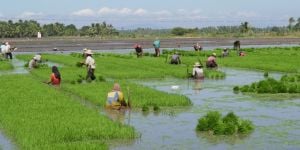how much i can earn with raise a pig
I'm thinking about living in Philippines. My income will give me a simple life but want to make more in some kind of business. I was thinking about live stock. But difficult to learn from just googling thinks . How much does it cost to buy feed for 1 pig and what is average profit. Thanks
By you dont have expirence raising pigs, I recomend you do someting else for EARNING
(but perhaps raise 1-2 pigs and some chickens to SAVE LIVING COSTS and to get experience to decide IF you want to start such for earning later.I
I know of three cases. (I have described them more detailed somewhere a while ago.)
1. One foreigner-Filipina couple beginners just BROKE EVEN by high foder costs.
2. One farmers daugher almost doubled her money in 4 months BUT
/ she took them for lower cost some younger than normal, did spend nothing at medical, got LUCKY they didnt get ill/died.
/it was perfect part of year by they got ready for lechon (=whole grilled piglet) at "exam party time" before covid, so better pay that part of year (March).
/Her brother worked for free  taking care of the 2 piglets and made the pigpen of SCRAP wood so no cost for the pigpen. (If raising pigs to biger, the pigpen has to be built much stronger.)
taking care of the 2 piglets and made the pigpen of SCRAP wood so no cost for the pigpen. (If raising pigs to biger, the pigpen has to be built much stronger.)
3. A Filipino farmer couple told they eaned around 3000pesos per pig (total in 4 months or longer)
BUT in their calculation they had counted NOTHING for the cost to make the (8) spots pigpen by concreete made by a hired "builder", INSPITE of the roof was close to falling in by it was wrong conctructed, so there will be at least costs for the roof soon...
. .
"Many" foreigners earn by own Youtube chanel  A few earn good but its a hard work to make a popular chanel, some work much more than a common work day hours answering emails, get ideas to good content and make new videos. BUT they have started geting hard competition from Filipinos making content foreigners are interested in.
A few earn good but its a hard work to make a popular chanel, some work much more than a common work day hours answering emails, get ideas to good content and make new videos. BUT they have started geting hard competition from Filipinos making content foreigners are interested in.
If you have English as first language you can perhaps get online tutor work.
Earlier Call Centers employed foreigners to teach Filipinos e g American ACCENT, but I dont know if they do still.
I do have experience with pigs
Also I understand the variables that come along with it.
I understand land feed medical are very important. A cycle must be created for consistent income. This is more expensive and difficult as land size building size very important. The capital expected is obviously unknown and what potential profits can average is also unknown. ROI is a cycle as to return for daily income is important as it would need to cover living expenses and operating expenses. If possible.
If you don’t know about keeping pigs stay away from
It , sunstroke disease and time effort and cost of feed , that’s my advice
Listen to the other people here. I know somebody who is very weathy from 200 head of pigs BUT she knows what she is doing. Her father is broke from raising chickens and he knew what he was doing.
kevin4586 wrote:If you don’t know about keeping pigs stay away from
It , sunstroke disease and time effort and cost of feed , that’s my advice
I agree. My better half used to own two small pig farms. She always struggled to make a small profit.
The pig farms are no longer an issue. My better half accompanied me when I left the country for a while on an extended overseas work assignment. The guy that she employed to manage the farms sold all the pigs, took the money, let the farms go into disrepair and ran away. He's now in jail. I'm not interested in re-investing to reinstate the farms.
i have pigs and chickens in cebu i make good money the reason why lots people not make money is because they sell the pig or chicken like that my advice is do it but sell the pig or chicken at market you kill or hire sombody to kill and prepere to sell at market you get 3 times that way then just sell pork per kilo about 300 paso say at market but if sell as live pig only 100 per kilo
Btw I got told a local athority DECIDED the price!!! (At Leyte where the couple with bad roof is located.) When got over lechon "max weight" then the price per kilo DROPED drasticaly! (I dont remember the prices. It was a few years ago anyway.)
. .
Someone with knowledge said when reaching a weight - diferent r different pig types - then no point go on fatening by above that weight raised weiht gain just cover the extra fooder costs.
bob hill wrote:i have pigs and chickens in cebu i make good money the reason why lots people not make money is because they sell the pig or chicken like that my advice is do it but sell the pig or chicken at market you kill or hire sombody to kill and prepere to sell at market you get 3 times that way then just sell pork per kilo about 300 paso say at market but if sell as live pig only 100 per kilo
She, who I told earned good, sold killed and prepared lechon at time to exam parties.
BassMan_720 wrote:kevin4586 wrote:If you don’t know about keeping pigs stay away from
It , sunstroke disease and time effort and cost of feed , that’s my advice
I agree. My better half used to own two small pig farms. She always struggled to make a small profit.
The pig farms are no longer an issue. My better half accompanied me when I left the country for a while on an extended overseas work assignment. The guy that she employed to manage the farms sold all the pigs, took the money, let the farms go into disrepair and ran away. He's now in jail. I'm not interested in re-investing to reinstate the farms.
Yes, I've heard the same stories with Sari Sari stores food being eaten, internet cafes equipment being sold, fish farms with the big fish being sold and replaced with small fish, and the foreigner not understanding why the fish never grew, etc. The concept of giving a person a fish dinner and them eating one meal versus teaching them how to fish and they can eat for a lifetime does not work very well here.
I use to raise pigs for my own consumption I would get a few pigs 800 to 1000 each takes 3 sacks of feed to get them butcher size about 80 to 90 kilo, I used commercial feed I sack starter, 1 sack grower,1 finisher I full feed them, you can do it cheaper if you grow some of your feed, but for my own consumption I didn't do it, now only me and my wife I just buy from my neighbor when he butchers
If you raise your own feed, you can do ok but buying commercial feed not so good, I use to raise pigs for my self, no profit you just get better meat
Over the past two decades, I have helped fund 2 piggeries and the purchase of some other piglets for someone to raise and sell. Unless someone has experience and knowledge it is a losing proposition. One piggery did not get the piglets vaccinated as I required and they lost every pig to swine flu. In all instances where I helped people to buy pigs to raise and sell, they did not make any money. One gal did surprisingly well but she has several sows that she breeds and that is where she makes the money. . . selling the piglets and she works very hard for the meager profit she makes.
Welcome to the forum seacaptdon.
I have watched this thread for many years but never contributed until now. I see a lot of people that raise and sell pigs and they are dirt poor but one of our workers, a builder with talent that we pay very well keeps disappearing, he and his family own a big piggery but they run it with entrepreneurial skills it seems and more lucrative to be at home than earning 700 pesos a day here.
Sure they sell pigs and piglets but their money apparently comes from processing, cooking and selling a finished product. A family and relative affair and they all seem to be doing well and they appreciate all the timber offcuts and chopped up trees we give them for cooking,,,,, 2 way street as they pick it up so we don't need to dispose and they get free fire.
One of Australia's ex prime minister (Paul Keating) had a 50% stake in one of the countries biggest piggeries, he did ok.
Cheers, Steve.
@bigpearl
I am always happy to hear success stories.
Part of my personal belief is that it is important to help people provide for themselves. . . which is why I have helped with such ventures before. Some people do well with taking advantage of an opportunity and some just cannot seem to grasp the concept. I am trying to find ways of being able to help people yet keep some accountability and mentorship to make them successful. That is one of several reasons I want to move to the Philippines.
Thank you for your comments and I appreciate any input and constructive evaluations.
I wish you a very good New Year.
I'm kinda surprised, and then never surprised. Huh? Well, most back yard piggery endeavors don't work. They don't profit. But WHY? That's the important question. I have numerous answers/opinions. All are based on a PROFITABLE backyard piggery my wife has operated for 10 years plus. But only got profitable about 6 -7 years ago.
- Filipino's (and others) are very cheap and poorly educated. Especially in raising hogs. Where/how do they learn? They learn from unsuccessful neighbors most likely.
- POOR breeding and bloodlines. If you buy any damn female you're gonna go broke. It's very important when buying gilts (young females that have not birthed piglets) to buy high quality breeds. Know the boar and it's bloodline. Know the gilt, it's mother and her bloodline.
- Unclean or not well setup piggery. Despite the thinking pigs are dirty creatures, we need reasonably clean housing to keep disease and virus away. This cleaning is constant. All of our pigs also get two baths per day. By hand!
- Cheap feed, or not the right balance of proteins, crude fat, etc.
- Not promptly caring for medical issues immediately. This includes soft pooping too. Calling that tech in asap with the right vitamins or antibiotics when things are not right. All feed suppliers also have techs that will come to the piggery as requested.
- Mating: Mating good sows/gilts with bad boars. Sometimes even their closest relative!
Now for some real world experience in a profitable back yard piggery: My wife was raising pigs for tiny profit before we met. But she was only one sick sow or too old sow away from no profit. We met and I started learning. Doing research online. Educating myself. We found a Brit married to a Filipina in Cebu that had a successful piggery and they sold gilts. They had about 200 head at any time. They sold piglets for others to raise. They sold Gilts (females 5 mo old) for breeding fatteners to market, and for breeding sows. (That's two different characteristics if only slight) And they sold to meat shops for slaughter. I made contact with them and they happily spent some time educating me more. They too initially made costly mistakes. But he sent his wife to Manila for some crash course education. They became very successful until they left for UK to raise their baby and sold the piggery. We learned a lot from them and bought two Gilts. They personally delivered them four hours away. The cost of these two gilts in roughly 2015 or 16 back then was roughly 36,000p total. Even today most pinoy won't spend that much.
Up to that point, Delia's slaughter pigs never weighed in at more than about 85 kilos. And that's on the large end. Avg was probably around 78-82 kilos. We followed the guidance from the Brit and his wife with the fully vaccinated properly bred gilts. When it was time for artificial insemination we went with another high quality boar and had the feed tech do the AI. The two gilts delivered 18 and 16 live piglets 115 days later. More than she had ever seen. She sold half of them to others to raise after they were weaned. But she also provided full vaccinations and stuff. Maintaining the quality for future return sales. Selling the piglets provided a boost in funds for feed of the remaining fatteners also. As instructed, we didn't make the fatteners available for slaughter to the meat shop until they had eaten an avg of 4 sacks of feed (not 3 as mentioned elsewhere in the thread). This amounted to between 5-6 months of age. The 5-6th month period is the fastest growth spurt-weight gain. Taking advantage of this period is paramount to maximum profit. When that first batch was slaughtered, we saw the lowest weigh of around 92 kilos, more than she had ever had before. And the max weight was 112 kilos! Which is right about USA slaughter weight also.
She's never looked back since then. We've had ups and downs because those folks we got the gilts from left the country and replacing that quality breeding is hard to find in the Phils. But even today we have some of the bloodline remaining in production. But it's thinned out with another breed that we've had to go with. That's not a bad thing. But we want to pick up some gilts soon. We know where we will go, and it will cost roughly 35,000 EACH gilt. But over a 7-8 litter period that's fine.
Pig farming for profit is not easy, takes time, and isn't cheap. But there is profit to be made. Just not instant profit, and not getting rich without going very big. Even that will require a ton of money and numerous years to recoup the investment.
Thanks for sharing Larry, I appreciate and I'm sure others also. The old saying in any business is crawl before you walk then hopefully reap the rewards.
Well done.
Cheers, Steve.
@Larry FisherThanks for sharing
my nephew and niece just started raising in SIQUIJOR and I will pass this on. You know that it is difficult to transport pigs between some provinces due to health controls for ASF (African Swine Flu); we cannot ship from Dumaguete to Siquijor and vice versa. I think anybody raising on Siquijor, a small island province, had a big advantage during Holidays due to lack of competition.
@seacaptdon Just a fyi. There is no vaccination or preventative treatment to ASF. Other than EXTREME cleanliness to keep other's that may have been contaminated (like a feed company tech, on his boots) walking into the piggery. We had some cases of ASF just within the last 90 days in our area. We were also harvesting 21 fatteners at the time. Normally, the slaughter boys come over and pick up 2-4 pigs at a time for slaughter that next early am for the wet market meat shop that buys all ours. We wouldn't let them on to our property. They didn't enter the piggery. We brought each pig out to the street and they took them from there. Not perfect, but doing what we can to prevent it. We've been fortunate, no ASF in our piggery yet. Hopefully never.
I'm curious...why nobody talking about bigger operations and export out?
I'm curious...why nobody talking about bigger operations and export out? - @DAVID TOH
For perspective, this is basically an expat site for individuals choosing to live here and possibly earn nominal amounts of money to help support themselves and their families in small businesses 60% owned by Filipinos or perhaps owned by Philippine citizen spouses. Of course, the necessary permits must be obtained for any employment by foreigners including the management of operations such as resorts, hotels, airbnb's, bars restaurants and...small piggeries. And sometimes such topics are discussed.
As for large operations and pork export businesses, this forum would probably not be an appropriate platform in my opinion but others can correct me if I am wrong
Pig farming is tough now. The swine flu is everywhere and there's no way to get around it. I would not make any kind of venture into that kind of farming now. My wife and I tried 2 years ago with a filipina friend of ours and we all had to give it up because of the swine flu.
Good luck.
Thanks guys and gals for all this information. Must agree Stuleer, in Palawan anyway, the small pig farming business appears especially tough. We went into partnership with our neighbors earlier this year, starting with a half dozen piglets. However for some reason, specialty pig feed is not produced locally and is therefore shipped across from Manila, so it's quite expensive.
Also for some reason we had trouble selling the piglets for a reasonable price, and so we needed to keep them and then raise them. We eventually sold them alive about a month ago at 160 peso per kilo. It was an experience, although we will not do it again.
We have now moved over into poultry and ducks, as well as our fruits and vegetables for our farm. Must say, it's all fun, and so until our recent plantings mature, making money isn't really a main thing yet. Our farm is simply a lovely place to spend quality time.
howdy, just another thought. Not sure if you are interested in fish, but we know a guy (in Cauayan) that farms rice, goats and fish. He has a pond with about 10,000 fish. As far as what he tells me it's a type of carp. I think he gets 2 harvests/year. He sells them to the local market and does ok with the amount of money he makes. They grow about 9, 10 inches then off to the market.......easy to raise. Only problems is if there is no rain, but that is usually not a problem. My wife and i ate some of his fish, on the grill, very tasty.
Just a idea. Good luck.
howdy, just another thought. Not sure if you are interested in fish, but we know a guy (in Cauayan) that farms rice, goats and fish. He has a pond with about 10,000 fish. As far as what he tells me it's a type of carp. I think he gets 2 harvests/year. He sells them to the local market and does ok with the amount of money he makes. They grow about 9, 10 inches then off to the market.......easy to raise. Only problems is if there is no rain, but that is usually not a problem. My wife and i ate some of his fish, on the grill, very tasty. Just a idea. Good luck. - @stuleer
Yes, thanks Stuleer. We understand that fresh-water fish can be a great companion harvest for wet-lands rice fields.
This year we haven't worried about planting out wet-land rice crops, as we did last year. We're busy enough building new farm homestead buildings and surrounding ground works. Next season we intend to plant out the rice fields again.
We are planning then to stock our rice fields with Tilapia. These are fresh water species of fish native to Africa.
Wikipedia says, "Tilapia are mainly freshwater fish inhabiting shallow streams, ponds, rivers, and lakes, and less commonly found living in brackish water. Traditionally a popular and affordable food in the Philippines with a mild taste, tilapia has been the fourth-most consumed fish in the United States since 2002, favored for its low cost and easy preparation. It is commonly fried or broiled." https://en.wikipedia.org/wiki/Tilapia
We will let you know the results if you like mate.
sure, let me know, thanks, and good luck.
We remain profitable in our piggery. Sold 21 piglets to others to raise because we were already at max capacity for fattening. Sold those 24 fatteners over a two week period to the meat shop. Avg slaughter weight (dressed) was right at 100 kilos. About 5 kilo below norm. We've got 13 fatteners born here that are about 3 months old so about 2.5-3 months to go for them. And have 12 piglets being weaned soon. Plus one sow do to deliver any day.
We're doing fine with it. Stay clean, feed well. Good breeds.
We remain profitable in our piggery. Sold 21 piglets to others to raise because we were already at max capacity for fattening. Sold those 24 fatteners over a two week period to the meat shop. Avg slaughter weight (dressed) was right at 100 kilos. About 5 kilo below norm. We've got 13 fatteners born here that are about 3 months old so about 2.5-3 months to go for them. And have 12 piglets being weaned soon. Plus one sow do to deliver any day.
We're doing fine with it. Stay clean, feed well. Good breeds. - @Larry Fisher
Question:
You may have seen my other post about medium to large size commercial businesses owned and or managed by foreigners. When writing that I did not realize that you as an expat have a pretty large business here as a pig farmer. This is of much more impact than some minor ma and pa piggery business to supplement the pension checks; you have a professional commercial operation and growing at that. Are there any special permits or licenses that a foreigner must secure in order to start a farming business like that? Are you subject to government inspections prior to putting products into thr supply chain? What are the tax implications? What are the llegal limitations on foreigners' ownership and management of commercial farming operations?
We are not large. That's only 4 sows. But we had four births very close together over about a 6 week period.
There's a larger, unprofitable piggery that just has to do it "their way" that is buying piglets to fatten and sell about 120 at a time not far from us.
The largest one I know of in our area has something like 60 sows and sells mostly lechon size in the city. And has a contract of sorts with the school system or something.
We've been inspected as a "backyard" piggery and they were impressed. Bio-gas, twice daily pig bathing, floors cleaned constantly. And with the ASF scare the baranguy captain also registered us for some sort of government insurance thing if we test positive. But our pigs have been fine and we protect it as well as possible.
It's not big business by any sense of the imagination.
I should have mentioned. The piggery is all hers. One hundred percent. She was doing it, albeit smaller with less success. I only added some to enlarge it just a little, add the bio-gas, and connected her with top breeding rather than the usual any female, any bore that 90% of people do venturing into this.
I should have mentioned. The piggery is all hers. One hundred percent. She was doing it, albeit smaller with less success. I only added some to enlarge it just a little, add the bio-gas, and connected her with top breeding rather than the usual any female, any bore that 90% of people do venturing into this. - @Larry Fisher
Thanks for the information.
Make your relocation easier with the Philippines expat guide

Setting up a business in the Philippines
In recent years, the Philippines has emerged as one of the fastest-growing economies in Southeast Asia, attracting ...

Work in the Philippines
With its thriving business sectors, skilled workforce, and a government committed to enhancing employment ...

Work in Cebu
What are the career prospects for expats in Cebu? How to proceed to find a job there? What is the work culture and ...

Work in Cagayan de Oro
Cagayan de Oro, officially known as the City of Cagayan de Oro, is a 1st class urbanized city in the Northern ...

Work in Davao
Located in Mindanao, Davao is a very dynamic city in economic terms, providing many professional opportunities for ...

Work in Iloilo
Located in the Visayas region, Iloilo was given the title 'Queen City of the South' for being the ...

Work in Manila
Manila, also referred to as the National Capital Region, is the capital city of the Philippines and the ...

Internship in the Philippines
Nowadays, globalization has a particular meaning for young professionals who are about to complete their higher ...
Forum topics on jobs in the Philippines




